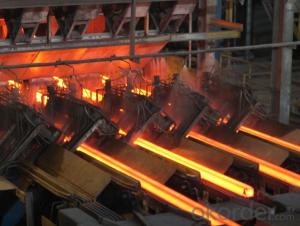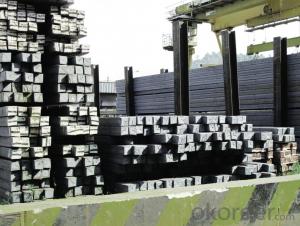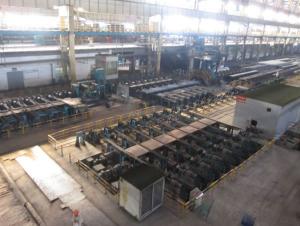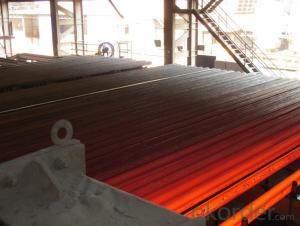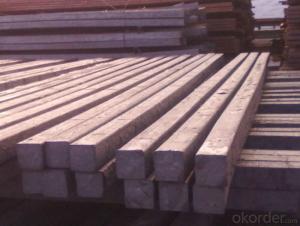Prime square alloy steel billet 95mm Q235
- Loading Port:
- Shanghai
- Payment Terms:
- TT OR LC
- Min Order Qty:
- 100 m.t.
- Supply Capability:
- 10000 m.t./month
OKorder Service Pledge
OKorder Financial Service
You Might Also Like
Structure of Prime square alloy steel billet 95mm Q235

Description of Prime square alloy steel billet 95mm Q235
1. Prepainted steel coil is coated with organic layer, which provides higher anti-corrosion property and a longer lifespan than that of galvanized or galvalume steel sheets.
2. The base metals for prepainted steel coil consist of cold rolled, HDGI Steel, electro-galvanized and hot-dip alu-zinc coated steel. The finish coats of prepainted steel coil can be classified into groups as follows: polyester, silicon modified polyesters, polyvinylidene fluoride, high-durability polyester, etc.
3. The production process has evolved from one-coating-and-one-baking to double-coating-and-double-baking, and even three-coating-and-three-baking.
4. The color of the prepainted steel coil has a very wide selection, like orange, cream-colored, dark sky blue, sea blue, bright red, brick red, ivory white, porcelain blue, etc.
5. The prepainted steel coils can also be classified into groups by their surface textures, namely regular prepainted sheets, embossed sheets and printed sheets.

Main Feature of Prime square alloy steel billet 95mm Q235
Uncoated CR steel sheet
With the features of in line with the international highest standards in demension and shape, excellent surface finish and properties, the products are mainly used in home appliance and automobile industries.
Galvanized steel sheet(include HDG and EG)
With the features of good corrosion resistance, the products are mainly used in automobile, home appliance, electronics, building and machinery manufacture industries, etc.
Precoated steel sheet
With the features of enviromental protection and good processablility, long lasting surface durability, rich in colors, the products are maily used in building, home appliance and furniture industries, etc.
Applications of Prime square alloy steel billet 95mm Q235
Polyester Coating Thickness:Top and Back coating thickness depend by Buyer Requirement.
Polyester Coating Type:2/2,1/2m,1/2.
Polyester Type: Polyester, silicone modified polyester, high durability polyester (HDP), polyvinylidene fluoride (PVDF)
Unit Roll Weight:5-20tons
Place of Origin Shanghai , China (Mainland)
Surface Treatment :Color Coated

Specifications of Prime square alloy steel billet 95mm Q235
Product | Billet |
Material Grade | SGCC / SGCH / DX51D+AZ, etc |
Thickness | 0.6-3.0mm |
Width | 500-1500mm |
Tolerance | Thickness: +/-0.02mm , Width:+/-2mm |
Zinc-coating | Z30-150g/m2 |
Technique | Raw material: Hot rolled steel coil --> Cold rolled_>hot dipped galvalume |
Surface | Dried, Chromated, Unoiled |
Spangle | Regular spangle , small spangle, zero spangle |
ID | 508MM 610MM |
Coil weight | 1-25MT |
Export package | Cardboard inner sleeves, Waterproof paper, galvanized steel covered and steel strip packed |
FAQ of Prime square alloy steel billet 95mm Q235
We have organized several common questions for our clients,may help you sincerely:
1. How Can I Visit There?
Our company is located in Tianjin City, China, near Beijing. You can fly to Tianjin Airport Directly. All our clients, from home or aboard, are warmly welcome to visit us!
2. How Can I Get Some Sample?
We are honored to offer you sample.
3. Why choose CNBM?
we always fix steel produce in container well to make it safe arrive at destination port
we always provide best and professional forward service for our buyer
we always apply 14days free detention for our buyers container in destination
we provide one set After-sales service for our buyer
we provide China inland steel market price report
we help our buyer become number one in local market .
- Q:Charcoal classification
- Hard charcoal. By hardwood such as Fagaceae Quercus, Castanopsis trees, secondary birch and etc..Broad-leaved charcoal. Charcoal made from a mixture of hard and soft hardwood.Pine charcoal. Carbon fired from pine or other needle wood. In addition to bamboo and bamboo charcoal burning with shells, stones (coconut shell, peach stone charcoal etc.) wood raw material firing. Charcoal collected from household stoves in the cell known as carbon. If the charcoal is crushed and mixed with proper adhesive, and then pressed, formed and roasted, the deposit is made. According to the burning process of silica and carbon black.
- Q:How can steel billets be recycled or reused?
- Steel billets can be recycled or reused in a number of ways. One common method is melting down the billets and using the molten steel to create new products. This process, known as remelting, allows for the steel to be reused in a variety of applications. Another way to recycle steel billets is by using them in the production of other steel products. For example, they can be used to make steel rods, pipes, or beams. By incorporating the billets into the manufacturing process, the steel industry can minimize waste and reduce the need for extracting new raw materials. Steel billets can also be repurposed in construction projects. They can be used as raw material for building structures, such as bridges, buildings, or highways. By using recycled steel billets, construction projects can reduce their environmental impact and contribute to a more sustainable future. Furthermore, steel billets can be transformed into smaller components through processes like rolling or forging. These components can then be used in various industries, including automotive, machinery, and infrastructure. By reusing steel billets in this way, we can reduce the need for producing new materials and conserve resources. Overall, recycling and reusing steel billets offer numerous benefits, including reducing waste, conserving resources, and promoting sustainability. With proper recycling and reuse practices, steel billets can have a second life in various industries, making them a valuable resource in the circular economy.
- Q:Can steel billets be used in the production of appliances?
- Yes, steel billets can be used in the production of appliances. Steel billets are semi-finished products that are typically used for further processing into various shapes and sizes. In the case of appliances, steel billets can be used as the raw material for manufacturing components such as frames, panels, and other structural parts. Steel is a versatile and durable material that offers strength, stability, and resistance to corrosion, making it suitable for use in appliances that require robust construction. Additionally, steel can be easily molded and shaped to meet the specific design requirements of different appliances, making it a preferred choice in the manufacturing process.
- Q:What are the different types of steel billets used in the manufacturing industry?
- There are several different types of steel billets used in the manufacturing industry, including carbon steel billets, alloy steel billets, stainless steel billets, and tool steel billets. Each type of billet has its own unique composition and properties, making them suitable for various applications in industries such as construction, automotive, and aerospace.
- Q:What is the role of steel billets in the manufacturing of hydraulic systems?
- The manufacturing of hydraulic systems heavily relies on steel billets, which have a crucial role to play. These billets serve as the raw material used for creating various components and structures within these systems. In order for hydraulic systems to function properly, it is imperative for their components to possess qualities such as strength, durability, and resistance to corrosion and pressure. Steel billets, due to their exceptional strength and toughness, are the perfect starting material for manufacturing hydraulic system components. Typically made from carbon steel, these billets offer excellent mechanical properties, including high tensile strength and hardness. These properties ensure that the components can endure the high pressures and forces encountered within hydraulic systems without deforming or failing. Furthermore, steel billets undergo several manufacturing processes such as forging, machining, and heat treatment in order to shape them into the desired components. These processes enable the creation of intricate designs and precise dimensions, guaranteeing a proper fit and functionality within the hydraulic system. Additionally, steel billets are renowned for their excellent resistance to corrosion, an essential quality in hydraulic systems due to the presence of fluids and potential exposure to moisture. Corrosion can lead to component failure, leaks, and a decrease in system performance. By utilizing steel billets, these issues can be prevented, ensuring the longevity and reliability of the hydraulic system. To sum up, steel billets are indispensable in the manufacturing of hydraulic systems as they provide the necessary strength, durability, and resistance to corrosion required for the components within these systems. Their versatility and ability to be shaped and processed make them an ideal material choice for creating reliable and efficient hydraulic systems.
- Q:What are the different types of steel billet inspection techniques?
- There are several types of steel billet inspection techniques, including visual inspection, ultrasonic testing, magnetic particle testing, dye penetrant testing, and eddy current testing.
- Q:What are the different machining processes for steel billets?
- There are several different machining processes that can be used for steel billets, depending on the desired outcome and the specific requirements of the project. Some of the most common machining processes for steel billets include: 1. Turning: This process involves rotating the steel billet against a cutting tool to remove material and create a desired shape or surface finish. Turning can be performed on both the outer and inner surfaces of the billet. 2. Milling: Milling is a versatile machining process that uses a rotating cutting tool to remove material from the surface of the steel billet. It can be used to create various shapes, slots, and holes, and is often employed for precision machining applications. 3. Drilling: Drilling is a machining process that uses a rotating drill bit to create holes in the steel billet. It is commonly used for creating holes of different sizes and depths, and is often a crucial step in the manufacturing of steel components. 4. Grinding: Grinding is a precision machining process that involves removing material from the surface of the steel billet using an abrasive wheel. It is typically used to achieve a smooth and precise finish or to remove any imperfections or irregularities on the surface. 5. Boring: Boring is a process that enlarges an existing hole in the steel billet to achieve a specific diameter or depth. It is often used to create holes with high levels of accuracy and precision, especially in applications where concentricity is critical. 6. Thread cutting: This process involves cutting threads into the steel billet using a specialized cutting tool. It is commonly used to create threaded holes or bolts, which are essential for joining steel components together. 7. Broaching: Broaching is a machining process that uses a specialized tool called a broach to remove material from the steel billet in a series of successive cuts. It is often used to create complex shapes, such as keyways or splines, on the surface of the billet. These are just a few examples of the different machining processes that can be used for steel billets. The choice of the specific process will depend on factors such as the desired outcome, the complexity of the shape, the required surface finish, and the tolerances that need to be achieved.
- Q:What are the different packaging options available for steel billets?
- There are several packaging options available for steel billets, including wooden crates, steel frames, and bundles with steel straps. These packaging options provide protection during transportation and storage, ensuring the integrity and quality of the steel billets.
- Q:What is the global production and consumption of steel billets?
- Steel billets play a crucial role in the worldwide construction and manufacturing sectors, with their production and consumption being of great significance. When it comes to manufacturing, several countries are major players in the production of steel billets. China, the largest producer of steel globally, contributes significantly to the global steel billet production. Other notable producers include India, Japan, Russia, the United States, and Turkey. These countries have well-established steel industries and infrastructure to support large-scale production. The consumption of steel billets is driven by the demand for steel products in various sectors. The construction and infrastructure development sectors are the primary drivers, as steel is widely used in the construction of buildings, bridges, roads, and other structures. The automotive industry is also a major consumer, utilizing steel billets for manufacturing automobile parts and components. Providing an exact figure for global steel billet production and consumption is challenging due to the ever-changing market dynamics and varying industry reports. However, it is estimated that global steel production exceeded 1.8 billion metric tons in 2020, with a significant portion of this production in the form of steel billets. The consumption of steel billets is closely linked to overall steel demand, which is influenced by economic growth, infrastructure development, industrial activity, and construction projects worldwide. In conclusion, the global production and consumption of steel billets are of great significance, highlighting the importance of steel as a vital material in various industries. The continuous growth in infrastructure development and industrialization globally is expected to further drive the production and consumption of steel billets in the years to come.
- Q:How are steel billets shaped into rods or wires?
- Steel billets are shaped into rods or wires through a process called hot rolling. Hot rolling involves passing the steel billets through a series of rollers at high temperatures. The first step is to heat the billets to a temperature above their recrystallization point, typically around 1200-1300 degrees Celsius. This temperature ensures that the steel is soft and malleable, making it easier to shape. Once the billets are heated, they are then fed through a series of rollers that gradually reduce their thickness and shape them into the desired rod or wire. These rollers apply pressure to the billets, causing them to elongate and decrease in thickness. The number of rollers and their configurations may vary depending on the specific requirements of the rod or wire being produced. During the hot rolling process, the steel undergoes plastic deformation due to the applied pressure and high temperatures. This plastic deformation allows the steel to change its shape without breaking or cracking. The continuous rolling and reduction of thickness gradually transform the billets into rods or wires. After the steel has been rolled to the desired size and shape, it is then cooled, typically through a process known as air cooling. This cooling process allows the steel to retain its new shape and hardness. The cooled rods or wires can then be further processed, such as through additional heat treatments or surface treatments, to enhance their properties and meet specific requirements. Overall, the hot rolling process is essential in shaping steel billets into rods or wires. It allows for the precise control of dimensions and properties while ensuring the final product meets the desired specifications.
1. Manufacturer Overview |
|
|---|---|
| Location | |
| Year Established | |
| Annual Output Value | |
| Main Markets | |
| Company Certifications | |
2. Manufacturer Certificates |
|
|---|---|
| a) Certification Name | |
| Range | |
| Reference | |
| Validity Period | |
3. Manufacturer Capability |
|
|---|---|
| a)Trade Capacity | |
| Nearest Port | |
| Export Percentage | |
| No.of Employees in Trade Department | |
| Language Spoken: | |
| b)Factory Information | |
| Factory Size: | |
| No. of Production Lines | |
| Contract Manufacturing | |
| Product Price Range | |
Send your message to us
Prime square alloy steel billet 95mm Q235
- Loading Port:
- Shanghai
- Payment Terms:
- TT OR LC
- Min Order Qty:
- 100 m.t.
- Supply Capability:
- 10000 m.t./month
OKorder Service Pledge
OKorder Financial Service
Similar products
New products
Hot products
Related keywords

